|
Link to research papers and articles: (http://wysinger.homestead.com/keita.html) |
|
Link to current African DNA research: (http://exploring-africa.blogspot.com/) |
|
Google Search- other data
Home page |
Home | Quotations | Misc Notes | Notes 2 | Hair | DemicDiff | Diversity | DNA| Asian IQ | Keita2008 data | Blood | Debunk3
Egypt
in Africa |
Black-Greek-DNA links | Notes
3 |Notes
4| Notes
5 | Notes
6 |
Notes 7 | Misc
news clips | Ethiopians
| Nubians
|
African Tmeline| Mesopotamia
| Egypt-
A Tropical Civ || KnolArchiv |
Notes8|
Notes
9 | Notes
10 | Notes
11
|
Link to research papers and articles: (http://wysinger.homestead.com/keita.html) |
|
Link to current African DNA research: (http://exploring-africa.blogspot.com/) |
|
Google Search- other data
Home page |
Egypt in Africa
Mainstream academic research
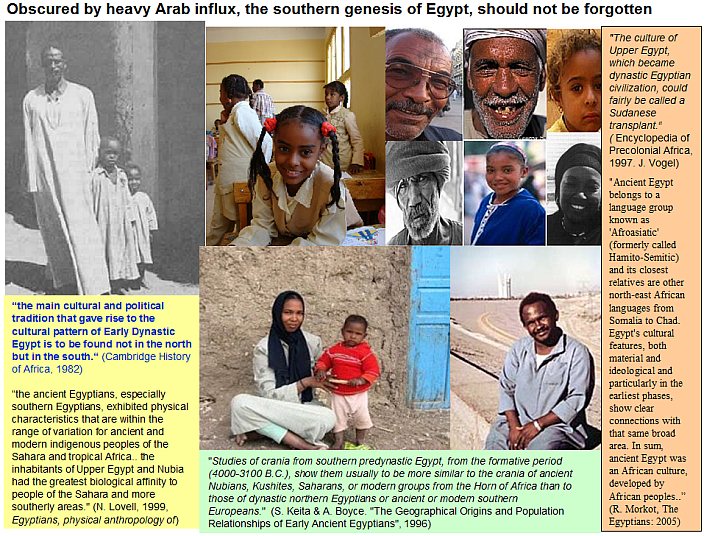
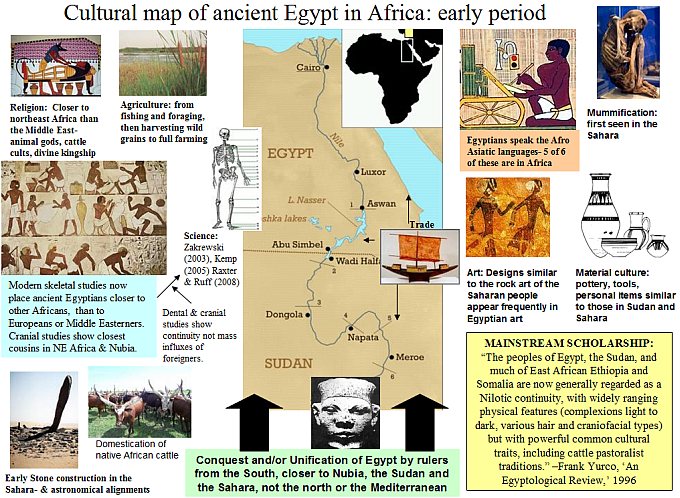
DATA from mainstream research studies
"The period when sub-Saharan Africa was most influential in Egypt was a time when neither Egypt, as we understand it
culturally, nor the Sahara, as we understand it geographically, existed. Populations and cultures now found south of the
desert roamed far to the north. The culture of Upper Egypt, which became dynastic Egyptian civilization, could fairly be
called a Sudanese transplant." (Egypt and Sub-Saharan Africa: Their Interaction. Encyclopedia of Precolonial Africa, by Joseph O. Vogel, AltaMira Press, Walnut Creek, California (1997), pp. 465-472 )[119]
"There is now a sufficient body of evidence from modern studies of skeletal remains to indicate that the ancient Egyptians,
especially southern Egyptians, exhibited physical characteristics that are within the range of variation for ancient and
modern indigenous peoples of the Sahara and tropical Africa.. In general, the inhabitants of Upper Egypt and Nubia had the greatest biological affinity to people of the Sahara and more southerly areas." (Nancy C. Lovell, " Egyptians, physical
anthropology of," in Encyclopedia of the Archaeology of Ancient Egypt, ed. Kathryn A. Bard and Steven Blake Shubert, ( London and New York: Routledge, 1999) pp 328-332)
"The peoples of Egypt, the Sudan, and much of East African Ethiopia and Somalia are now generally regarded as a Nilotic
continuity, with widely ranging physical features (complexions light to dark, various hair and craniofacial types) but with
powerful common cultural traits, including cattle pastoralist traditions." (Frank Yurco, "An Egyptological Review," 1996 -in
Mary R. Lefkowitz and Guy MacLean Rogers, Black Athena Revisited, 1996, The University of North Carolina Press, p. 62-100)
"..sample populations available from northern Egypt from before the 1st Dynasty (Merimda, Maadi and Wadi Digla) turn out to be significantly different from sample populations from early Palestine and Byblos, suggesting a lack of common ancestors over a long time. If there was a south-north cline variation along the Nile valley it did not, from this limited evidence, continue smoothly on into southern Palestine. The limb-length proportions of males from the Egyptian sites group them with Africans rather than with Europeans."
(Barry Kemp, "Ancient Egypt Anatomy of a Civilisation. (2005) Routledge. p. 52-60)
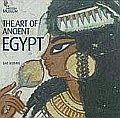
----------------------
QUOTE(s) FROM S.O.Y. Keita, Anthropologist
S. O. Y. Keita, "Studies and Comments on Ancient Egyptian Biological Relationships," History in Africa 20 (1993) 129-54
"Overall, when the Egyptian crania are evaluated in a Near Eastern (Lachish) versus African (Kerma, Kebel Moya, Ashanti)
context) the affinity is with the Africans. The Sudan and Palestine are the most appropriate comparative regions which would have 'donated' people, along with the Sahara and Maghreb. Archaeology validates looking to these regions for population flow (see Hassan 1988)... Egyptian groups showed less overall affinity to Palestinian and Byzantine remains than to other African series, especially Sudanese." (Keita 1993)
"When the unlikely relationships [Indian matches] and eliminated, the Egyptian series are more similar overall to other
African series than to European or Near Eastern (Byzantine or Palestinian) series."
(Keita 1993)
"Analysis of crania is the traditional approach to assessing ancient population origins, relationships, and diversity. In
studies based on anatomical traits and measurements of crania, similarities have been found between Nile Valley crania from 30,000, 20,000 and 12,000 years ago and various African remains from more recent times (see Thoma 1984; Brauer and Rimbach 1990; Angel and Kelley 1986; Keita 1993).
Studies of crania from southern predynastic Egypt, from the formative period (4000-3100 B.C.), show them usually to be more similar to the crania of ancient Nubians, Kushites, Saharans, or modern groups from the Horn of Africa than to those of dynastic northern Egyptians or ancient or modern southern Europeans."
(S. O. Y and A.J. Boyce, "The Geographical Origins and Population Relationships of Early Ancient Egyptians", in Egypt in
Africa, Theodore Celenko (ed), Indiana University Press, 1996, pp. 20-33)
"There is no archaeological, linguistic, or historical data which indicate a European or Asiatic invasion of, or migration to, the Nile Valley during First Dynasty times. Previous concepts about the origin of the First Dynasty Egyptians as being somehow external to the Nile Valley or less native are not supported by archaeology... In summary, the Abydos First Dynasty royal tomb contents reveal a notable craniometric heterogeneity. Southerners predominate.
(Kieta, S. (1992) Further Studies of Crania From Ancient Northern Africa: An Analysis of Crania From First Dynasty Egyptian Tombs, Using Multiple Discriminant Functions. AMERICAN JOURNAL OF PHYSICAL ANTHROPOLOGY 87:245-254)"
"The predominant craniometric pattern in the Abydos royal tombs is 'southern' (tropical African variant), and this is consistent with what would be expected based on the literature and other results (Keita, 1990).
This pattern is seen in both group and unknown analyses... Archaeology and history seem to provide the most parsimonious explanation for the variation in the royal tombs at Abydos.. Tomb design suggests the presence of northerners in the south in late Nakada times (Hoffman, 1988) when the unification probably took place. Delta names are attached to some of the tombs at Abydos (Gardiner, 1961; Yurco, 1990, personal communication), thus perhaps supporting Petrie's (1939) and Gardiner's contention that north-south marriages were undertaken to legitimize the hegemony of the south. The courtiers of northern elites would have accompanied them. "
"Given all of the above, it is probably not possible to view the Abydos royal tomb sample as representative of the general southern Upper Egyptian population of the time.
Southern elites and/or their descendants eventually came to be buried in the north (Hoffman, 1988). Hence early Second Dynasty kings and Djoser (Dynasty 111) (Hayes, 1953) and his descendants are not buried in Abydos. Petrie (1939) states that the Third Dynasty, buried in the north, was of Sudanese origin, but southern Egypt is equally likely. This perhaps explains Harris and Weeks' (1973) suggested findings of southern morphologies in some Old Kingdom Giza remains, also verified in portraiture (Drake, 1987). Further study would be required to ascertain trends in the general population of both regions. The strong Sudanese affinity noted in the unknown analyses may reflect the Nubian interactions with upper Egypt in predynastic times prior to Egyptian unification (Williams,
1980,1986)..." (S. Keita (1992) Further Studies of Crania From Ancient Northern Africa: An Analysis of Crania From First Dynasty Egyptian Tombs, Using Multiple Discriminant Functions. AMERICAN JOURNAL OF PHYSICAL ANTHROPOLOGY 87:245-254)
"An examination of the distance hierarchies reveals the Badarian series to be more similar to the Teita in both analyses and always more similar to all of the African series than to the Norse and Berg groups (see Tables 3A & 3B and Figure 2). Essentially equal similarity is found with the Zalavar and Dogon series in the 11-variable analysis and with these and the Bushman in the one using 15 variables. The Badarian series clusters with the tropical African groups no matter which algorithm is employed (see Figures 3 and 4)..
In none of them did the Badarian sample affiliate with the European
series."(S.O.Y. Keita. Early Nile Valley Farmers from El-Badari: Aboriginals or "European" Agro-Nostratic Immigrants? Craniometric Affinities Considered With Other Data. Journal of Black Studies, Vol. 36 No. 2, pp. 191-208 (2005)
-------------------------------------
Dental studies
(Joel D. Irish (2006). Who Were the Ancient Egyptians? Dental Affinities
Among Neolithic Through Postdynastic Peoples. Am J Phys Anthropol. 2006
Apr;129(4):529-43.)
"Despite the difference, Gebel Ramlah [the Western Desert- Saharan region] is closest to predynastic and early dynastic samples from Abydos, Hierakonpolis, and Badari.." [the Badarians ]are a "good representative of what the common ancestor to all later predynastic and dynastic Egyptian peoples would be like"
"A comparison of Badari to the Naqada and
Hierakonpolis samples .. contradicts the idea of a foreign origin for the Naqada
(Petrie, 1939; Baumgartel, 1970)"
Evidence in favor of continuity is also demonstrated by comparison of individual
samples. "Naqada and especially Hierakonpolis share close affinities with
First–Second Dynasty Abydos.. These findings do not support the concept of a
foreign dynastic ‘‘race’’"
"Thus, despite increasing foreign influence after the Second Intermediate
Period, not only did Egyptian culture remain intact (Lloyd, 2000a), but the
people themselves, as represented by the dental samples, appear biologically
constant as well."
-----------------------------------
"Some have argued that various early Egyptians like the Badarians probably migrated northward from Nubia, while others see a wide-ranging movement of peoples across the breadth of the Sahara before the onset of desiccation. Whatever may be the origins of any particular people or civilization, however, it seems reasonably certain that the predynastic communities of the Nile valley were essentially indigenous in culture, drawing little inspiration from sources outside the continent during the several centuries directly preceding the onset of historical times..." (Robert July, Pre-Colonial Africa, 1975, p. 60-61)
"overall population continuity over the Predynastic and early Dynastic, and high levels of genetic heterogeneity, thereby suggesting that state formation occurred as a mainly indigenous process."
(Zakrzewski, S.R. (2007). "Population continuity or population change: Formation of the ancient Egyptian
state". American Journal of Physical Anthropology 132 (4): 501-509)
German Institute for Archaeology -excavation of the tombs of the nobles in Thebes-West, Upper Egypt. In several of the noble specimens:
"The basal epithelial cells were packed with melanin as expected for specimens of Negroid origin."
(Determination of optimal rehydration, fixation and staining methods for histological and immunohistochemical analysis of mummified soft tissues", Biotechnic & Histochemistry 2005, 80(1): 7_/13)
QUOTE(s):
Encyclopedia Britannica 1984 ed. Macropedia Article, Vol 6: "Egyptian Religion" , pg 506-508
"A large number of gods go back to prehistoric times. The images of a cow and star goddess (Hathor), the falcon (Horus), and the human-shaped figures of the fertility god (Min) can be traced back to that period. Some rites, such as the "running of the Apil-bull," the "hoeing of the ground," and other fertility and hunting rites (e.g., the hippopotamus hunt) presumably date from early times.. Connections with the religions in southwest Asia cannot be traced with certainty."
"It is doubtful whether Osiris can be regarded as equal to Tammuz or Adonis, or whether Hathor is related to the "Great Mother." There are closer relations with northeast African religions. The numerous animal cults (especially bovine cults and panther gods) and details of ritual dresses (animal tails, masks, grass aprons, etc) probably are of African origin. The kinship in particular shows some African elements, such as the king as the head ritualist (i.e., medicine man), the limitations and renewal of the reign (jubilees, regicide), and the position of the king's mother (a matriarchal element). Some of them can be found among the Ethiopians in Napata and Meroe, others among the Prenilotic tribes (Shilluk)."
(Encyclopedia Britannica 1984 ed. Macropedia Article, Vol 6: "Egyptian Religion" , pg 506-508)
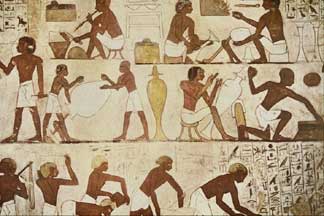
"While communities such as Ma'adi appear to have played an important role in entrepots through which goods and ideas form south-west Asia filtered into the Nile Valley in later prehistoric times, the main cultural and political tradition that gave rise to the cultural pattern of Early Dynastic Egypt is to be found not in the north but in the
south.":
The Cambridge History of Africa: Volume 1, From the Earliest Times to c. 500 BC, (Cambridge University Press: 1982), Edited by J. Desmond Clark pp. 500-509
"..the early cultures of Merimde, the Fayum, Badari Naqada I and II are essentially African and early African social customs and religious beliefs were the root and foundation of the ancient Egyptian way of life." (Source: Shaw, Thurston (1976) Changes in African Archaeology in the Last Forty Years in African Studies since 1945. p. 156-68. London.)
"Ancient Egyptian civilization was, in ways and to an extent usually not recognized, fundamentally African. The evidence of
both language and culture reveals these African roots. The origins of Egyptian ethnicity lay in the areas south of Egypt. The
ancient Egyptian language belonged to the Afrasian family (also called Afroasiatic or, formerly, Hamito-Semitic). The
speakers of the earliest Afrasian languages, according to recent studies, were a set of peoples whose lands between 15,000
and 13,000 B.C. stretched from Nubia in the west to far northern Somalia in the east. (Christopher Ehret (1996) "Ancient
Egyptian as an African Language, Egypt as an African Culture." In Egypt in Africa Egypt in Africa, Theodore Celenko (ed),
Indiana University Press)
"Ancient Egypt belongs to a language group known as 'Afro-Asiatic' (formerly called Hamito-Semitic) and its closest relatives
are other north-east African languages from Somalia to Chad. Egypt's cultural features, both material and ideological and
particularly in the earliest phases, show clear connections with that same broad area. In sum, ancient Egypt was an African
culture, developed by African peoples, who had wide ranging contacts in north Africa and western Asia." (Morkot, Robert
(2005) The Egyptians: An Introduction. Routledge. p. 10)
Limb-proportion or body-plan studies tell
us much about ancient Egyptian populations
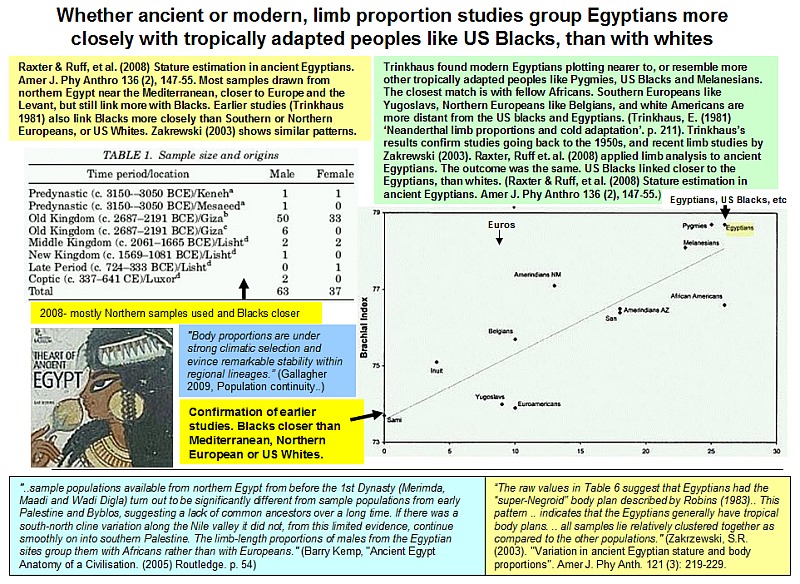
Limb proportion studies are more stable and are more reliable and are a viable alternative to cranio-facial studies say mainstream scientists. Limbs are more robust than facial elements. EARLY OR OLDER Europeans - Mesolithics, Neolithics, etc - tend to resemble Africans in various studies of the Nile Valley ancients, because they still have tropical adaptation. In other words, they look like tropically adapted Africans to begin with, more than modern Europeans. When comparisons are run between the Ancient Egyptians, Black Americans, and White Americans, its the tropically adapted black Americans that are closer to the Ancient Egyptians than any of the others. As regards modern Egyptians, Black Americans, Pygmies, white Americans and white Southern and Northern Europeans, modern Egyptians tend to cluster with dark-skinned tropical peoples like other Africans (Pygmies) or people of African background (Black Americans), or there is resemblance to other tropical peoples like Melanesians.
Quote:
"Body proportions are under strong climatic selection and evince remarkable stability within regional lineages. As such, they offer a viable and robust alternative to cranio-facial data in assessing hypothesised continuity and replacement with the transition to agro-pastoralism in central Europe.. Mesolithic Europeans display considerable variation in humero-clavicular and brachial indices yet none approach the extreme "hyper-polar" morphology of LBK humans from the MESV. In contrast, Late Neolithic and Early Bronze Age peoples display elongated brachial and crural indices reminiscent of terminal Pleistocene and "tropically adapted" recent humans."
(Gallagher A, Gunther MM, Bruchhaus H. Population continuity, demic diffusion and Neolithic origins in central-southern Germany: the evidence from body proportions. (Homo. 2009;60(2):95-126. Epub 2009 Mar 4)
"We also compare Egyptian body proportions to those of modern American Blacks and Whites... Long bone stature regression equations were then derived for each sex. Our results confirm that, although ancient Egyptians are closer in body proportion to modern American Blacks than they are to American Whites, proportions in Blacks and Egyptians are not identical... Intralimb indices are not significantly different between Egyptians and American Blacks. ..brachial indices are definitely more ‘African’... There is no evidence for significant variation in proportions among temporal or social groupings; thus, the new formulae may be broadly applicable to ancient Egyptian remains." ("Stature estimation in ancient Egyptians: A new technique based on anatomical reconstruction of stature." Michelle H. Raxter, Christopher B. Ruff, Ayman Azab, Moushira Erfan, Muhammad Soliman, Aly El-Sawaf, (Am J Phys Anthropol. 2008, Jun;136(2):147-55

Peoples of the Sahara were an important part of the foundations of ancient Egypt and pioneered in several features that were to appear in Egypt, including religion, cattle cults, stone construction and astronomy etc. Some mainstream scientists consider the Saharans more organized on some counts than the early Egyptians. Also the Saharan culture shares clear links with other African peoples. Of note again is the southern direction of this cultural pioneering and growth, not the north, the Middle East, or the Mediterranean. It was from the south, that Egypt was consolidated and organized to usher int he dynastic period.
QUOTE:
"Located 100 km west of Abu Simbel, in southernmost Egypt, Nabta Playa is a large, internally drained basin, which during the early Holocene ( ca. 11,000 - 5500 calibrated radiocarbon years ago) was a large and important ceremonial center for prehistoric people.. today it contains dozens, and perhaps hundreds, of archaeological sites. People came from many regions to Nabta Playa to record astronomical events, erect alignments of megaliths, and build impressive stone structures..
... they built Egypt's earliest astronomical measuring device (a "calendar circle" which appears to have been used to mark the summer solstice), and they constructed more than 30 complex structures having both surface and subterranean features. A shaped stone from one of these complexes may be the oldest known sculpture in Egypt.
These structures are important because they indicate the way the people were able to organize work, celebrate their culture, and perhaps express their religious beliefs, and furthermore, they tell us that the Saharan people may have been more highly organized than their contemporaries in the Nile Valley.
Among the more interesting elements in the cultural debris at this gathering site were numerous bones of cattle. While present in most sites, bones of cattle are elsewhere never very numerous, good evidence that they were kept primarily for their milk and blood, rather than for meat. This pattern resembles the role of cattle among modern African pastoralists, where cattle represent wealth and political power and are rarely killed except on important ceremonial or social occasions, such as the death of a leader or a marriage. This so-called "African Cattle Complex" may have begun in the Western Desert of Egypt.
The role of Nabta as a regional ceremonial center is also indicated by a north-south alignment of nine large (average, 3 x 2 x 0.5 m) quartzitic sandstone slabs ... About 300 m beyond the north end of the Nabta alignment is a "calendar circle" consisting of a series of small sandstone slabs arranged in a circle about 4 m in diameter. Among the ring of stones are four pairs of larger stones, each pair set close together and separated by a narrow space, or gate. The gates on two of these pairs align generally north-south; the gates on the other two pairs form a line at 700 east of north, which aligns with the calculated position of sunrise at the summer solstice 6000 years ago..
The top of the table rock was also smoothed. The pit was then partially refilled with playa clay to a level about a half meter above the top of the table rock, and then an enormous (ca. 2.5 tons), carefully shaped stone was brought in and held in position by several small slabs..
The construction of the megaliths and the large complex structures at Nabta required significant effort, indicating the presence of a religious or political authority with control over human resources for an extended period of time. They, together with the calendar circle and cattle burials, represent an elaborate and previously unsuspected ceremonialism in the Neolithic of the Eastern Sahara. Although the evidence remains insecure and thus it cannot be demonstrated that these Saharan cattle pastoralists had a ranked society, this is, nevertheless, a strong possibility.
The discoveries at Nabta Playa suggest the possibility of a previously unrecognized relationship between the Neolithic people living along the Nile and pastoralists in the adjacent Sahara which may have contributed to the rise of social complexity in ancient Egypt. This complexity, as expressed by different levels of authority within the society, forms the basis for the structure of both the Neolithic society at Nabta and the Old Kingdom of Egypt. It was this authority at Nabta which made possible the planned arrangement of their villages, the excavation of large, deep wells, and the construction of complex stone structures made of large, shaped and unshaped stones. There are other Nabta features which are shared by the two areas, but which appear suddenly and without evident local antecedents in the late Predynastic and early Old Kingdom in the Nile Valley. These include the role of cattle to express differences of wealth, power and authority, the emphasis on cattle in religious beliefs, and the use of astronomical knowledge and devices to predict solar events. Many of these features have a prior and long history of development at Nabta.
The geographic position of the Nabta center is also of interest. Nabta may have been a contact point between the early Neolithic groups along the Nile who had an agricultural economy and the cattle pastoralists in the Eastern Sahara. The functional separation of these two different economies may have played a significant role in the emergence of complexity among both groups. The evidence for Nilotic influence on pastoralists is not extensive and is presently limited to ceramic technology, domestic caprovids, and the occasional trade of shells of Nile species and rare stones from the Nile gravel. However, there are many aspects of political and ceremonial life in the Predynastic and Old Kingdom that reflects a strong impact from Saharan cattle pastoralists.
The likely possibility of a symbiotic relationship between the cattle pastoralists in the Sahara and the Neolithic groups in the Nile Valley points to a potentially important role for the Nabta regional ceremonial center. Among East African cattle pastoralists regional ceremonial centers, because of their integrative role, are frequently placed near boundaries between different segments of a tribe, or between different tribal groups. The Nabta center could well have served that purpose, it could have been located between several groups of pastoralists, and between pastoralists and the Neolithic farmers along the Nile, 100 km away.
It has long been assumed that Egypt borrowed the concepts of complexity from Mesopotamia; however, it is now generally recognized that a process like social complexity cannot be diffused from one area to another, but instead develops from local causes. It might occur, for example, when there are two radically different economic systems in close physical proximity, as is found where agriculturists have close relationships with pastoralists. Pastoralists usually live in tense harmony with their village neighbors, but from time to time they will take advantage of a weakness and take control. It is in this setting that the socially complex Late Neolithic cattle pastoralists and their regional ceremonial center at Nabta is of particular importance.
There are many features in the religious beliefs and social systems of early Egyptians which are not found in Mesopotamia. Among the ancient Egyptians, cattle were the central focus of the belief system. They were deified and regarded as earthly representatives of the gods. A cow was also seen as the mother of the sun, who is sometimes referred to as the "Bull of Heaven." The Egyptian pharaoh was regarded as the embodiment of two gods, Horus, for Upper Egypt and Seth, for Lower Egypt, but he was primarily Horus, son of Hathor, who was a cow. Horus is also sometimes depicted as a strong bull, and images of cattle are prominent in Predynastic and Old Kingdom art; in some instances images of bulls occur with depiction's of stars. Another important Old Kingdom concept was Min, the god of rain, who is associated with a white bull, and to whom the annual harvest festival was dedicated."
(Malville, Wendorf, Mazar, and Schild (1998). Late Neolithic megalithic structures at Nabta Playa (Sahara), southwestern Egypt.. NATURE 292:488-491 2 April 1998.)
Image
gallery | Articles
| Google
Nubians were ethnically the closest people to the Egyptians. Conflict between the two were typical clashes between kingdoms without the simplistic "racial" models drawn by some 20th century writers.
Quote 1:
“The ancient Egyptians referred to a region, located south of the third cataract the
Nile River, in which Nubians dwelt as Kush.. Within such context, this phrase is not a racial slur. Throughout the history of ancient Egypt there were numerous, well documented instances that celebrate Nubian-Egyptian marriages. A study of these documents, particularly those dated to both the Egyptian New Kingdom (after 1550 B.C.E.) and to Dynasty XXV and early Dynasty XXVI (about 720-640 BCE), reveals that neither spouse nor any of the children of such unions suffered discrimination at the hands of the ancient Egyptians. Indeed such marriages were never an obstacle to social, economic, or political status, provided the individuals concerned conformed to generally accepted Egyptian social standards. Furthermore, at times, certain Nubian practices, such as tattooing for women, and the unisex fashion of wearing earrings, were wholeheartedly embraced by the ancient Egyptians."
(Bianchi, 2004: p. 4)
'It is an extremely difficult task to attempt to describe the Nubians during the course of Egypt's New Kingdom, because their presence appears to have virtually evaporated from the archaeological record.. The result has been described as a wholesale Nubian assimilation into Egyptian society. This assimilation was so complete that it masked all Nubian ethnic identities insofar as archaeological remains are concerned beneath the impenetrable veneer of Egypt's material; culture.. In the Kushite Period, when Nubians ruled as Pharaohs in their own right, the material culture of Dynasty XXV (about 750-655 B.C.E.) was decidedly Egyptian in character.. Nubia's entire landscape up to the region of the Third Cataract was dotted with temples indistinguishable in style and decoration from contemporary temples erected in Egypt. The same observation obtains for the smaller number of typically Egyptian tombs in which these elite Nubian princes were interred. (Bianchi, 2004, p. 99-100)
- Robert Bianchi ( 2004). Daily Life of the Nubians. Greenwood Publishing Group
Quote 2:
"the XIIth Dynasty (1991-1786 B.C.E.) originated from the Aswan region.4 As expected, strong Nubian features and dark coloring are seen in their sculpture and relief work. This dynasty ranks as among the greatest, whose fame far outlived its actual tenure on the throne. Especially interesting, it was a member of this dynasty- that decreed that no Nehsy (riverine Nubian of the principality of Kush), except such as came for trade or diplomatic reasons, should pass by the Egyptian fortress at the southern end of the Second Nile Cataract. Why would this royal family of Nubian ancestry ban other Nubians from coming into Egyptian territory? Because the Egyptian rulers of Nubian ancestry had become Egyptians culturally; as pharaohs, they exhibited typical Egyptian attitudes and adopted typical Egyptian policies."
- (F. J. Yurco, 'Were the ancient Egyptians black or white?', Biblical Archaeology Review (Vol 15, no. 5, 1989)

Egyptian origin stories hold to an ancestral home in Africa not Asia
"It may be noted that the ancient Egyptians themselves appear to have been convinced that their place of origin was African rather than Asian. They made continued reference to the land of Punt as their homeland." --(White, Jon Manchip., Ancient Egypt: Its Culture and History (Dover Publications; New Ed edition, June 1, 1970), p. 141.)
Mainstream scholars note numerous cultural links are shared between Egypt
and surrounding African areas:

New data on Egypt and Nubia show that the two peoples shared a cultural and material unity, undermining older simplistic separationist and 'racial' theories
"Any Egyptian evidence in Nubia was seen as an import or as cultural
influence, while any Nubian evidence in Upper Egypt was viewed as the sporadic presence of
foreign people within Egyptian territory.
In the last few years, new research on the subject, particularly from a Nubian point of view,
shows that the interaction between the two cultures was much more complex than previously thought,
affecting the time, space and nature of the interaction (Gatto & Tiraterra 1996; Gatto 2000, 2003a,
2003b). The Aswan area was probably never a real borderline, at least not until the New Kingdom. Of
particular importance in this perspective is the area
between Armant and Dehmit, south of the First Cataract, as well as the surrounding deserts, and
for the availability of data, more specifically the Western Desert.
The data recently collected and a new interpretation of available information are bringing
to light a stable and long-term interaction between Upper Egypt and Lower Nubia that has to be seen
in a very different perspective. The two regions, and so their cultural entities, are not in antithesis
to one another, but in the Predynastic period are
still the expression of the same cultural tradition, with strong regional variations, particularly in the
last part of the 4th millennium BC. Some of them are clearly connected with the major cultural and
political changes of Egypt."
(-- Maria Carmela GATTO (British Museum, London) 2002. "At the Origin of the Egyptian Civilisation: Reconsidering the Relationship between Egypt and Nubia in the Pre- and Protodynastic Periods."
Conférence internationale / International Conference L'Egypte pré- et protodynastique. Les origines
de l'Etat Predynastic and Early Dynastic Egypt. Origin of the State. Toulouse (France) - 5-8 sept. 2005)

Gravestone of the Nubian soldier Nenu, circa
2250-2060 B.C. Here he holds the tools of his trade as an
archer - bow and quiver of arrows. Also depicted is his Egyptian wife. The
Nubians and Egyptians shared common genes and a common culture (Yurco 1989,
Gatto, 2005). Disputes were political not racial, and both black and brown skin
are native to
Home | Quotations | Misc Notes | Hair | DemicDiff |
Link to research papers and articles: (wysinger.homestead.com/keita.html) |
Link to current African DNA research: (http://exploring-africa.blogspot.com/) |
|
Google Search- other data |